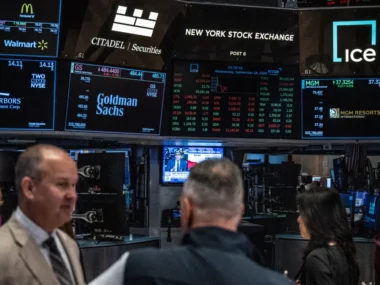Pandemic recoveries are not uniform across all nations.
The wealthiest economies of the world have followed different trajectories in their efforts to bounce back from the severe impacts of the Covid-19 pandemic.
Amidst a backdrop of multiple challenges and crises, including conflicts, geopolitical tensions, the ongoing repercussions of the pandemic, high inflation, and substantial borrowing costs, global growth has seen limited positive developments.
The United States economy is among the standout performers. In the third quarter, the country recorded an impressive 5.2% growth in its gross domestic product (GDP), surpassing China, which has long been considered the driving force behind global economic growth.
“In the past year, the US has consistently outperformed compared to other nations,” noted Innes McFee, the Chief Global Economist at Oxford Economics, in an interview with CNN.
The United States has surged ahead of advanced economies like the European Union, the United Kingdom, Japan, Canada, and others in terms of economic performance this year.
Recently, the Organisation for Economic Co-operation and Development (OECD), based in Paris, joined other international organizations in revising its growth forecasts. It upgraded its predictions for US growth for both this year and the next, while simultaneously downgrading the outlook for the 20 countries in the euro currency zone.
This follows a similar shift in forecasts by the International Monetary Fund (IMF) in October. The IMF now anticipates that the US GDP will expand by 2.1% this year and 1.5% in 2024, which is more than double the growth rates expected for the UK economy and significantly ahead of the euro area, where growth is projected to be 0.7% this year and 1.2% next year.
The contrasting outcomes among the world’s most advanced economies can be attributed to several immediate factors, including disparities in energy prices, the stimulus measures implemented during the pandemic, and the impact of higher interest rates.
However, there are also enduring structural factors contributing to this divergence, providing the United States with a competitive advantage. Nevertheless, it is widely anticipated that the US economy will experience a significantly slower growth rate in the last few months of the year, primarily due to the depletion of pandemic-related savings and persistently high borrowing costs, which are currently at their highest level in 22 years.
Prices for energy resources
According to Clare Lombardelli, the Chief Economist of the OECD, the primary factor responsible for the divergence between the economies of the United States and the euro area has been the consequences of the significant increase in energy prices that occurred last year.
Inflation in Europe has outpaced that in the United States due to the fact that the European region, including the United Kingdom, relies heavily on energy imports. Both the UK and the euro area were significantly affected by the sharp increase in natural gas prices that followed Russia’s full-scale invasion of Ukraine in February 2022, leading to record-high energy bills for households and businesses.
Preston Caldwell, Chief US Economist for Morningstar Research Services, pointed out that while oil is a globally traded commodity, natural gas has regional market segments. Consequently, even though natural gas prices rose in the United States as well, they surged much higher in Europe, leading to various forms of rationing. This, in turn, had a substantial impact on output, with some of these effects persisting.

A natural gas pipeline in northeastern Germany. The country’s extensive manufacturing sector has suffered significant impacts from the steep rise in energy prices triggered by the conflict in Ukraine.
Germany bore the brunt of the energy shock due to its substantial manufacturing sector and dependence on Russian natural gas during that period. The largest economy in Europe experienced a minor contraction in output during the third quarter, and several economists are now anticipating a technical recession, which is defined as two consecutive quarters of declining economic activity.
Government spending and central bank policies regarding interest rates and money supply
While policymakers on both sides of the Atlantic responded to the economic challenges posed by the Covid-19 pandemic with fiscal stimulus measures, the United States embarked on a much larger scale of intervention.
This extensive government support, which included debt payment moratoriums, coupled with changing consumption habits and a “refinancing boom” driven by historically low interest rates, contributed to the accumulation of savings among Americans.
According to Carsten Brzeski, the Global Head of Macroeconomic Research at Dutch bank ING, the savings accrued during the pandemic enabled US consumers to continue spending despite rising prices. This helped offset the adverse effects of inflation on consumption, which is a primary driver of the US economy.
However, there may be potential downsides to this increased spending. Americans have drawn heavily from their savings over the past few years, while savings accounts in other countries have remained relatively intact. This could create pockets of vulnerability for the United States in the future, as noted by McFee at Oxford Economics.
Furthermore, the United States has yet to fully experience the impact of higher interest rates. Mortgage holders and corporate borrowers in the US typically refinance less frequently than those in other countries, resulting in a longer lag time for monetary policy to influence the economy, according to McFee.
The deceleration in China’s economic growth.
It is uncommon for the growth rate of the US economy to match that of China. China, the world’s second-largest economy, had a strong start to the year following three years of Covid-related restrictions. However, its economic recovery lost steam in the April-to-June quarter due to factors such as weak consumer spending, a prolonged downturn in the real estate sector, and subdued global demand for China’s manufactured goods.
Julian Evans-Pritchard, the Chief China Economist at Capital Economics, expressed concerns that the Chinese economy appeared as if it could have “stalled altogether” during the summer.
However, there has been some recent improvement in China’s economic momentum, with increased consumer confidence and accelerated retail sales in recent months, as noted during an online briefing with journalists and investors.

Analysts anticipate that the decline in the property sector is likely to persist, potentially impeding China’s economic growth prospects for an extended period.
An emerging increase in government spending aimed at supporting the economy will provide some uplift. However, the persistent decline in China’s vast property sector and a potential weakening in exports, which have remained relatively robust until now, will exert downward pressure on growth, as noted by Evans-Pritchard.
He further commented, “We think by the end of next year the economy will be slowing again.”
In another indication of the less optimistic outlook for China’s economy, Moody’s has placed the country on notice for a potential credit rating downgrade. They have revised the outlook on China’s government debt from “stable” to “negative.”
Moody’s anticipates that China’s annual growth rate will slow to 4% in both 2024 and 2025, with an average of 3.8% per year from 2026 to 2030. In contrast, in the decade before the pandemic, China’s economy grew at an average annual rate of 7.7%, according to data from BlackRock.
Meanwhile, India is expected to expand by 6.3% this year and next, according to the IMF, making it the world’s fastest-growing major economy and presenting a rising challenge to its neighbor, China.
Anticipated deceleration in U.S. economic growth, with the prospect of a significant upsurge in the field of artificial intelligence (AI).
While the robust performance of the U.S. economy has defied expectations, economists anticipate a probable slowdown ahead. Instead, there is an expectation of a modest deceleration in economic growth for the current quarter and the next year. Morningstar’s Caldwell forecasts annualized growth rates, which are favored in the United States, to be under 1% during the second and third quarters. He emphasizes that this is approaching a low range but not negative or indicative of a recession. Although a recession is possible, it is not the base-case scenario.
Several prominent bank CEOs, including Jane Fraser of Citigroup and Jamie Dimon of JPMorgan Chase, have also expressed concerns that the U.S. economy may face increased uncertainty in the near future.
However, when looking at the longer-term perspective, the outlook appears brighter and may solidify America’s lead over Europe in the years to come. President Joe Biden’s Inflation Reduction Act, which allocates $369 billion for clean energy projects, has the potential to attract more investment to the United States, which is already considered one of the most favorable global destinations for capital raising.
In the field of artificial intelligence (AI), the United States has seen substantial cumulative venture capital investment of nearly $450 billion over the past decade, according to OECD data. This figure surpasses AI investments in China by more than double and exceeds those in the European Union and the United Kingdom by almost tenfold.
The United States benefits from a concentration of innovative tech companies and the rapid adoption of new technologies, leading to significant productivity gains, particularly when compared to Europe and the UK, as stated by Andrew Kenningham, Chief Europe Economist at Capital Economics. With the United States well-positioned to capitalize on AI advancements, this gap in productivity could widen further.











